Have Your Say: How do inclusive workspaces utilise sensory design?
At Design Insider we recognise the expertise within commercial interiors and we are proud to instigate conversations which inform, challenge & inspire the people who make our sector thrive.
We’ve brought together industry experts to share their perspectives on their use of sensory design by asking: How do inclusive workspaces utilise sensory design?
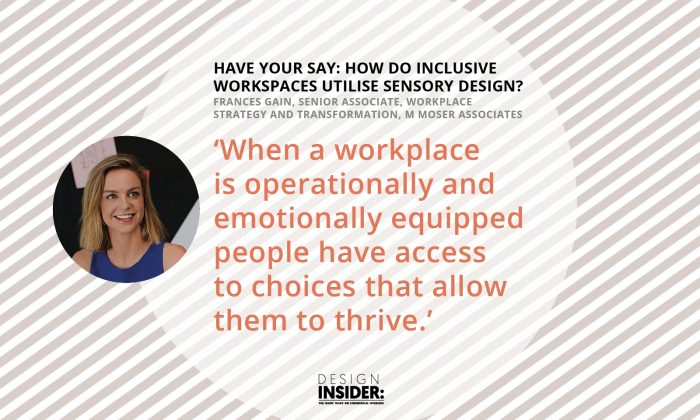
Inclusivity’ in today’s workplace goes beyond encouraging and celebrating diversity. It involves innovative physical design and the development of a culture of belonging. When a workplace is operationally and emotionally equipped people have access to choices that allow them to thrive.
Recognising the challenges faced by individuals with sensory processing disorders, the focus is on creatively addressing these issues universally. A well-thought-out design plan accommodates diverse needs, ensuring harmony among the five senses without overwhelming stimuli.
The workplace experience, from visual appeal to scent and sound, needs to be meticulously considered, acknowledging cultural variations. Sensory seekers and avoiders should be supported through flexible designs, reflecting the understanding that preferences may change throughout the day. The ‘return to office’ prompts a reflection on how inclusivity can be achieved, emphasising a collaborative approach where everyone’s input is valued.
Practical, cost-effective adjustments to office designs, such as varied lighting, scents and designated spaces for different needs can significantly impact client and staff experiences. By creating flexible microenvironments and empowering people to customise their workspaces for optimal comfort and productivity, we can better support inclusivity.
Frances Gain, Senior Associate, Workplace Strategy and Transformation, M Moser Associates
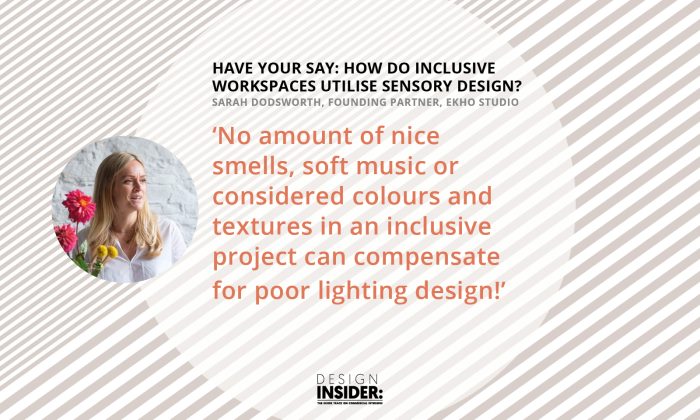
For me personally, no amount of nice smells, soft music or considered colours and textures in an inclusive project can compensate for poor lighting design, making lighting the number one factor in enabling successful sensory design.
Bad lighting can totally mess up a thoughtfully constructed colour and materials palette. I’m speaking from experience on a scheme I designed many years ago; when the lighting was installed, it really had a negative effect on the overall experience, environment and ambience we were striving to create. I was devastated! I made a pact with myself then and there to learn more about this critical aspect of interior design.
Lighting (whether natural or artificial) significantly affects our Circadian rhythms and our internal body clocks, which in turn also control alertness, hunger, digestion, urine production, body temperature, and the secretion of hormones. That’s a pretty powerful set of senses right there!!
Sarah Dodsworth, Founding Partner, Ekho Studio
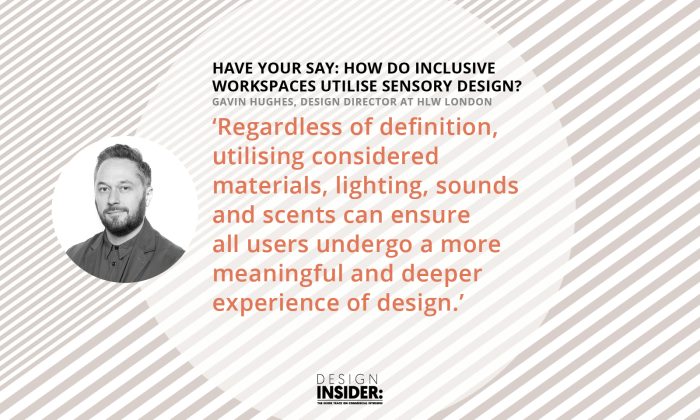
The Senses: Vision, hearing, touch, smell, and taste.
The generally accepted answer regarding how many senses humans have is five, but many suggest it is much more complicated than that. They could be more than five, or they could be distilled to the physical source of information sent to our brains: mechanical, chemical, and light.
Regardless of definition, utilising considered materials, lighting, sounds and scents can ensure all users undergo a more meaningful and deeper experience of design.
Touch. It’s paramount to consider how users can physically engage with an element, such as a bespoke piece of joinery, a door handle, a wall surface, or a piece of furniture. Carefully considered materiality can hugely impact a user’s experience, for example with a material that conveys warmth, texture, softness, as opposed to coldness and stiffness.
Vision. It is widely known that our body’s reaction to light is what regulates our circadian rhythm, which affects our cognition, blood pressure, immune system, metabolism, and controls our sleep/wake cycle.
Hearing. On film, George Lucas states that “sound is 50% of the entertainment”, which stresses the importance of getting acoustic design right, including careful consideration of where the most buzz will be, and where quiet retreats should be located.
Smell. It’s a running joke in our office; no one appreciates when a colleague microwaves their fish in the office. At the opposite end of the spectrum, it’s rare anyone complains about the smell of fresh coffee from a client’s in-house barista.
Taste. Taste is a more difficult one to control, unless we introduce Willy Wonkas ‘Lickable Wallpaper’ – however, a workplace that offers great free food from a well-designed cafe on a dedicated day of the week or month is a great place to start.
Gavin Hughes, Design Director, HLW London
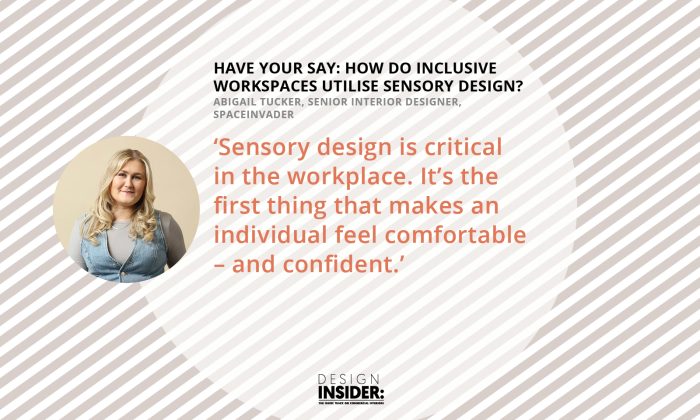
Sensory design is critical in the workplace. It’s the first thing that makes an individual feel comfortable – and confident. The enhancement of user experience starts with navigation. Clear, easy-to-understand wayfinding at appropriate heights, sizing and visual clarity makes the user journey effortless from the start.
We also look to create a sound landscape, where levels of sound are increased or decreased depending on the tasks or energy of a particular space through the control of acoustics, background music and the placement of quiet or loud working areas. The ability to personalise spaces is another way to make workspaces more inclusive, enabling the user to control lighting intensity, music, room temperature etc.
In terms of aesthetics and tactility, variety is key, giving individuals choice in the types of settings they can work at and considering the placement of colour/textures. Some areas might be more tactile and colourful to stimulate creativity and community, whilst others may be texturally softer and more organic for a calmer, focused feel.
Abigail Tucker, Senior Interior Designer, SpaceInvader
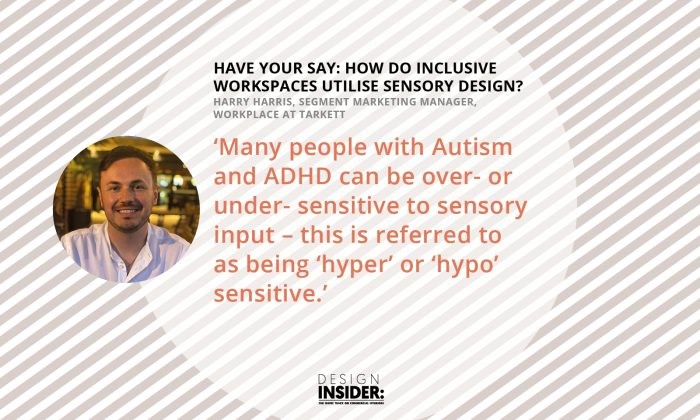
Inclusive workplaces leverage sensory design to accommodate individuals with varying sensitivities, particularly neurodiverse individuals. Many people with Autism and ADHD can be over- or under- sensitive to sensory input – this is referred to as being ‘hyper’ or ‘hypo’ sensitive. An individual can also be hypersensitive to some sensory stimuli and hyposensitive to others, so flexibility in design is key. For hyposensitive individuals, it’s important to provide more sensory stimuli to encourage sensory processing. Plenty of colour, light, texture, and visual interest provides a more productive environment. On the other hand, designing for hypersensitivity requires the opposite. A less vibrant colour scheme, reduced textures, contrast, smells, and noise helps to create a more soothing environment where hypersensitive individuals can thrive. In both cases, control over the environment is crucial. By allowing a user to control elements of the space, it becomes more personalised to the needs of the user and therefore more inclusive.
Harry Harris, Segment Marketing Manager, Workplace, Tarkett
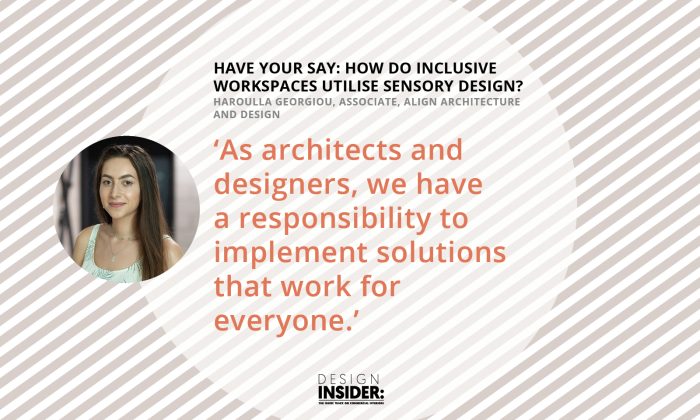
Inclusive design’ refers to the creation of environments that can be easily accessed and used by as many people as possible, regardless of age, ability or gender. Although this principle is still at the forefront of every good design scheme, in recent years we have witnessed an increased interest in and understanding of neurodiversity, which has broadened the sensory design remit further.
As architects and designers, we have a responsibility to implement solutions that work for everyone. By designing schemes that offer the end user a wide array of choices such as adjustable seating, controlled lighting / temperature and clearly-defined signage, coupled with colour schemes that stimulate the senses and promote emotional wellbeing, we can create environments that redefine people’s experience of a building.
In open-plan, agile and flowing spaces, ‘refuge’ areas, which calm rather than stimulate and allow people the option for solo working and offer enough peace and quiet to reboot their senses, are vital.
Haroulla Georgiou, Associate, Align Architecture and Design
We’re interested in the use of sensory design across the commercial sector, so we also asked James Dilley, Director and Head of Hospitality at Jestico + Whiles an extra question: What role does sensory design play in the creation of successful hospitality spaces?
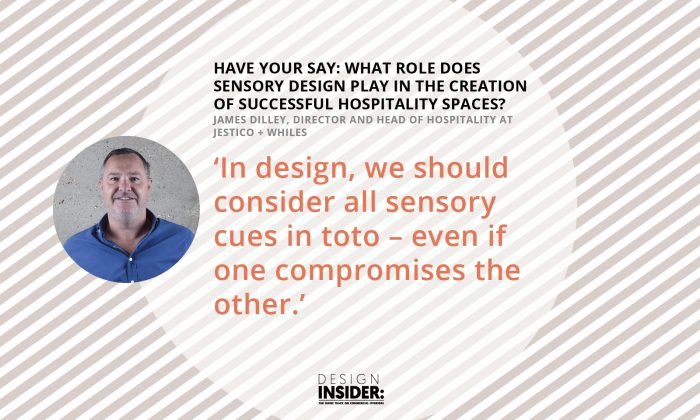
Proust wrote of the sensory power of the madeleine. Crayola crayons’ unique scent is so evocative that it is now patented. And the fresh leather smell of a new Bentley – so good they’ve bottled it – confirms its quality and hand-crafted excellence.
We are currently designing a restaurant that needs a high acoustic performance. There was a suggestion of using a silent coffee machine, to avoid the intrusive sound of steam mode and bean grinding. But in doing so, those sensory cues that confirm authenticity and quality would be lost. In design, we should consider all sensory cues in toto – even if one compromises the other. A real wood fire makes a hospitality space feel welcoming and authentic not just through the sight of flickering flames, but through its smoky smell and the crackle of logs that fill the room. Take any one of these sensory stimuli away, and the joy and delight of the fire – and the experience of the space – will be diminished.
(…as I write, I am imagining if the soles of James Bond’s shoes were made of rubber that squeaks, rather than good, hand-stitched leather that makes a satisfying “clack” as he strides into the next chapter… all kinds of wrong!)
James Dilley, Director and Head of Hospitality, Jestico + Whiles
For our next Have Your Say article we are asking: When designing for the care sector how do the senses need to be addressed?
We would love to publish your opinion, please email your answer (50-150 words), name, title, company and portrait to alys@designinsiderlive.com Copy deadline 23rd February.





